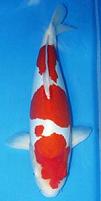|
KOHAKU
General
Description
'Kohaku'
is the term applied to a koi that has a
white body
with
red markings.
Kohaku is the first koi breed to be established by the
Japanese, with breed stability being achieved in the 1890's.
Appreciation
Criteria
Color
The
shiro (white) base color of the body must be unblemished,
thick, snowy, and even milky. The shiro must not exhibit any
yellowish tint.
The
hi
(red) markings on the
white body must be solid, deep, and evenly-colored throughout
the entire body. The edges of these markings (also known as
the 'kiwa') must be very defined, or as they say, 'sharp as a
razor.'
The hi color may vary from koi to koi, but it should be of
uniform hue within an individual koi.
Different koi exhibit different hues, from a deep persimmon
orange to dark, purplish red. This entire range is
acceptable, although judges invariably have their own
preferences.
Pattern
The red markings on the body must be artistically
balanced.
This means that they must not be confined to one side or one
end of the koi only. An equal distribution of shiro and
hi is preferred, so in general a koi heavily marked with red
or predominantly white in color is not desired. Red spots
below the lateral line are not desired, and so are red marks
that extend into the tail or the dorsal fin.
The pattern may be continuous or 'stepped', but the over-all
effect of white and red balancing each other should be the
ultimate consideration. Many people prefer stepped koi and understandably so, since this pattern ensures red and white
alternating with each other. Nonetheless, there have
been single-stepped (also known as
'ohmoyo') koi that have won
championships for their 'total package' elegance.
A
white area separating the tail and the red marking nearest the
tail is known as a tail stop, and is considered desirable. A
red mark on the lips of a koi (also known as
'kuchibeni') is a
'plus' if it enhances the over-all package of the koi.
A
good kohaku has a pattern on the head. The head pattern must
extend slightly beyond the eyes but should not reach the nose
or lips, leaving a white area in the front end of the head.
A fully red head (referred to as
'menkaburi') that makes the
koi look 'hooded' is considered negative. Nonetheless,
some koi look good despite having it, so don't let it prevent
you from buying a koi that you like.
A
round patch of red on the head is considered nice. If
this red patch is the only marking on a white koi, then the
koi is called a
'tancho
kohaku', a highly-prized koi variety
among the Japanese since it looks like their national bird.
If there are other markings on the body of the koi, then the
round head patch makes it a
'maruten'
kohaku.
Body
Please see separate article on
The Ideal Koi Body.
|
 |
|
 |
|
Kohaku |
Photos' source:
www.keirinponds.com
|